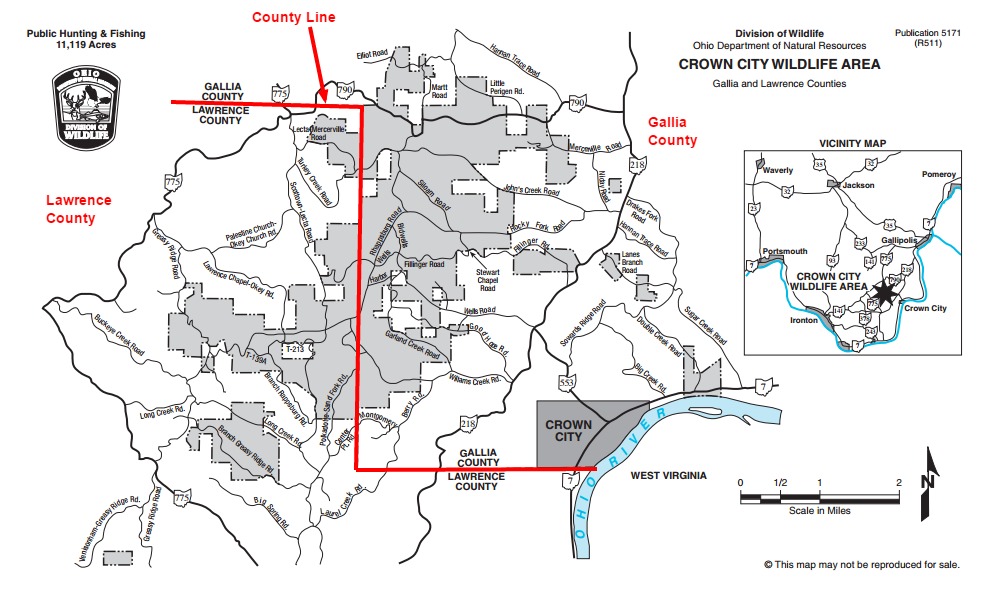Crown City Wildlife Area (Lawrence Co.)
Crown City Wildlife Area (Lawrence Co.)
Scottown, Ohio 45678
Crown City Wildlife Area Official WebsiteCrown City Wildlife Area map
Also, see all the hotspots at:
Crown City Wildlife Area Important Bird Area
Lawrence County Birding Drive
Tips for Birding
The most southerly of Ohio’s reclamation grasslands, the Crown City Wildlife Area is a beautiful and unique area in the state. Although it is an out-of-the-way destination for most visitors, its birdlife still makes it a worthwhile place to visit. The grasslands along Rhappsburg Road and Siloam Road are likely to be of top interest to birders, but other roads radiating out from here hold an interesting assortment of woodland birds in the spring and summer.
Crown City Wildlife Area can be a confusing place for the first-time visitor to find. The Ohio DeLorme Atlas is accurate for the roads outside the area but comes nowhere close for roads in the wildlife area itself. The roads in the area aren’t signposted anywhere, and you’ll even find a few roads that aren’t on the ODNR map. Don’t be put off by that, though, since it’s a beautiful and fascinating area that is well worth a visit.
To reach Crown City Wildlife Area from the Shawnee State Forest, take OH-52 east out of Portsmouth to Ironton. At Ironton take OH-141 north to Wilgus. At Wilgus continue straight ahead onto OH-775 to Lecta (which is just a few buildings). Refer to page 86 of the De Lorme Ohio Atlas. At Lecta turn east onto OH-790 and pull out the Crown City Wildlife Area map, which can be downloaded at the address above. Enter the area from the north onto an unmarked road about a mile and a half east of Lecta along OH-790.
To reach Crown City Wildlife Area from the north come down OH-35 from Chillicothe. Again refer to page 86 of the De Lorme Ohio Atlas. From Rio Grande take OH-325 south until it ends at OH-141. On OH-141 take a right (west), then a quick left (south) onto Patriot-Gage Road. After zig-zagging through the small community of Patriot, continue south on Hannan Trace Road until it reaches OH-775 a few miles later. Continue south on OH-775 to Lecta and enter Crown City Wildlife Area as described above from OH-790.
From Gallipolis (the nearest city with hotels and restaurants), Crown City Wildlife Area can be reached by taking OH-7 south to OH-218. Continue south on OH-218 to )H-790, turning west and entering the wildlife area in the same spot mentioned above.
Open all year during daylight hours.
There are no formal parking areas, but pulling off to the side of the road is permitted anywhere.
Birds of Interest
Winter
Short-eared Owl, Rough-legged Hawk, Northern Harrier.
Spring
Bobolinks, many other migrants, and arriving summer birds.
Summer
Characteristic breeding birds of the area include Henslow’s and Grasshopper Sparrows, Blue Grosbeak, Dickcissel (erratic), Orchard Oriole, Prairie Warbler. Other breeding birds include Northern Bobwhite, Yellow-billed and Black-billed Cuckoos, Acadian and Willow Flycatchers, Eastern Kingbird, Eastern Phoebe, Eastern Wood-Peewee, White-eyed, Yellow-throated, and Red-eyed Vireos, Wood Thrush, Gray Catbird, Brown Thrasher, Blue-winged, Yellow, Yellow-throated, Cerulean, Kentucky, and Hooded Warblers, American Redstart, Ovenbird, Common Yellowthroat, Louisiana Waterthrush, Yellow-breasted Chat, Scarlet Tanager, Eastern Towhee, Chipping, Field, and Song Sparrows, Indigo Bunting, and Eastern Meadowlark. Always unpredictable and erratic anywhere in Ohio, Sedge Wrens were noted singing on territory here in May 2005.
Fall
A wide variety of migrants have been reported and could potentially show up. CCWA is worthy of more exploration at this season.
About Crown City Wildlife Area
See all hotspots at Crown City Wildlife Area
The 11,119-acre Crown City Wildlife Area, located in portions of Lawrence and Gallia counties, is situated in southern Ohio approximately 3 miles south of Mercerville. The primary access to the wildlife area is from OH-218 and OH-790.
Crown City Wildlife Area is located in the unglaciated region of southern Ohio. The terrain, dissected by numerous small streams, is rolling to rugged. Elevations vary from 515 feet to 1,060 feet above sea level. Much of the land that comprises Crown City Wildlife Area has been subjected to surface mining. It consists of 67 percent forestland, 32 percent grassland/open land, and less than 1 percent wetlands and ponds.
Crown City Wildlife Area was purchased from Barrick Gold by the Richard King Mellon Foundation in 1997 as part of their American Land Conservation Program. They, in turn, donated it to the Division of Wildlife. Before European settlement, this area was a virgin forest. Today all of the forests are second or third-growth timber.
Surface mining took place in Crown City from 1975 to 1987. As with other strip-mined lands, Crown City Wildlife Area affords the opportunity to provide habitat for declining grassland nesting species. Active management activities include managing 600 acres of native warm season grasses and annually planting 40 acres of food plots for dove fields. The forested portion of Crown City is managed for recreational opportunities and will continue to be maintained to offer a diversity of successional stages providing a variety of game and non-game wildlife species.
No restroom facilities.
Content from Crown City Wildlife Area Official Website and Ohio Ornithological Society
